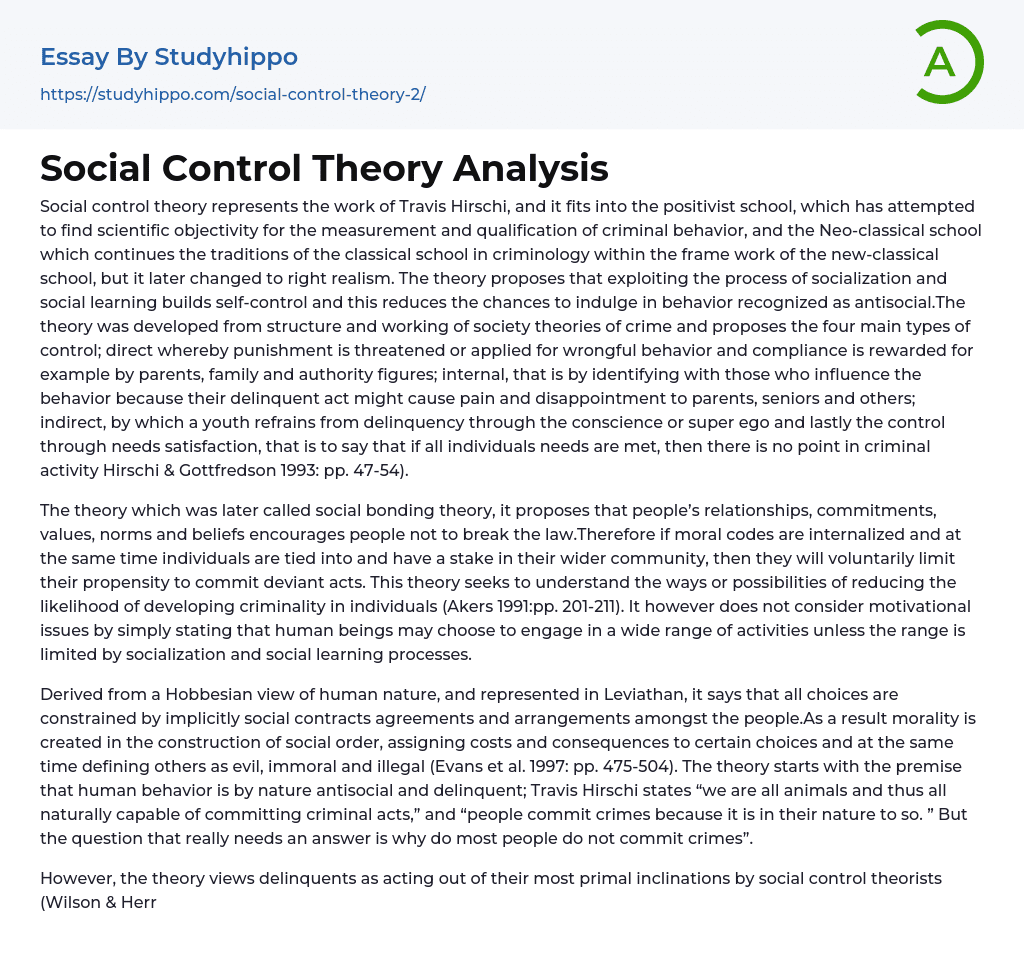Travis Hirschi's Social Control Theory belongs to both the positivist and Neo-classical schools of criminology. The theory aims to objectively measure and qualify criminal behavior. Originally aligned with the classical school, it later shifted to right realism. The theory proposes that building self-control through socialization and social learning can reduce the likelihood of engaging in antisocial behavior. The theory identifies four main types of control: direct (punishment or rewards from authority figures), internal (identification with those who would be hurt by delinquency), indirect (conscience or super ego), and control through needs satisfaction (lack of motivation for criminal activity when needs are met). (Hirschi ; Gottfredson, 1993: pp. 47-54)
The theory, known as social bonding theory, proposes that individuals are less likely to engage in illegal activities when they have strong connections to society, such as through relations
...hips, commitments, values, norms, and beliefs. By internalizing moral codes and being tied to their community, people will voluntarily limit their inclination towards deviant behavior. This theory seeks to understand ways of reducing criminal tendencies in individuals (Akers 1991:pp. 201-211), but does not address motivational factors beyond the role of socialization and social learning processes.
According to the theory presented in Leviathan, which stems from a Hobbesian view of human nature, all choices are limited by implicit social contracts, agreements, and arrangements between people. This results in the creation of morality through the establishment of social order that assigns costs and consequences to certain decisions while defining others as immoral, evil, or illegal (Evans et al. 1997: pp. 475-504). The theory begins from the premise that human behavior is inherently antisocial and delinquent, as Travis Hirschi stated: "We are all animals
and therefore naturally capable of committing criminal acts," and that "people commit crimes because it is in their nature to do so." However, the question that remains unanswered is why most individuals do not engage in criminal behavior.
According to social control theorists (Wilson ; Herrnstein 1985: pp. 234-246), delinquents are believed to act on their primal inclinations. This theory suggests that individuals in a society establish bonds with others, such as parents, pro-social friends, churches, schools, teachers, and sports teams (Hirschi ; Gottfredson 1993: pp. 47-54). Hirschi identified four social bonds that are critical for shaping an individual's behavior. These include emotional ties to key people in one's life, commitment to social norms and values such as education, job success, and law abidance, involvement in activities that limit the time for trouble, and the belief and respect for the law (Hirschi ; Gottfredson 1993: pp. 47-54).
By creating bonds, an individual can develop stronger social capital and internalize society's norms, such as being a law-abiding citizen. This perspective on the theory can explain juvenile delinquency, as those who do not form bonds or develop the same level of social capital are more likely to engage in criminal activity. This deficiency in socialization is what makes juveniles more prone to criminal activity. Right Realism, also known as new right realism, is the polar opposite of left realism according to Akers (1990: pp. 653-676).
- Values of Life essays
- Ethical dilemma essays
- Normative Ethics essays
- Virtue Ethics essays
- Belief essays
- Deontology essays
- Moral essays
- Virtue essays
- Work Ethic essays
- Acceptance essays
- Age Of Enlightenment essays
- Child Observation essays
- Confucianism essays
- Conscience essays
- Critical Reflection essays
- Destiny essays
- Determinism essays
- Empiricism essays
- Environmentalism essays
- Epistemology essays
- Ethics essays
- Ethos essays
- Existence essays
- Existentialism essays
- Fate essays
- Free Will essays
- Functionalism essays
- Future essays
- Good And Evil essays
- Human Nature essays
- Individualism essays
- Meaning Of Life essays
- Metaphysics essays
- Natural Law essays
- Personal Philosophy essays
- Philosophers essays
- Philosophy Of Life essays
- Political Philosophy essays
- Pragmatism essays
- Reality essays
- Relativism essays
- Teaching Philosophy essays
- Time essays
- Transcendentalism essays
- Truth essays
- Utilitarianism essays
- Animal Cruelty essays
- Charles Manson essays
- Crime Prevention essays
- Crime scene essays




